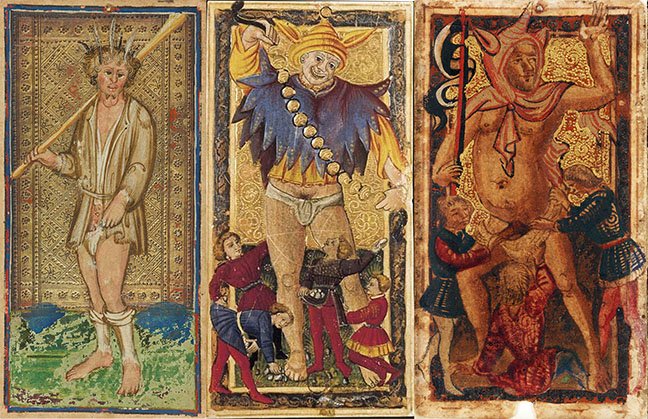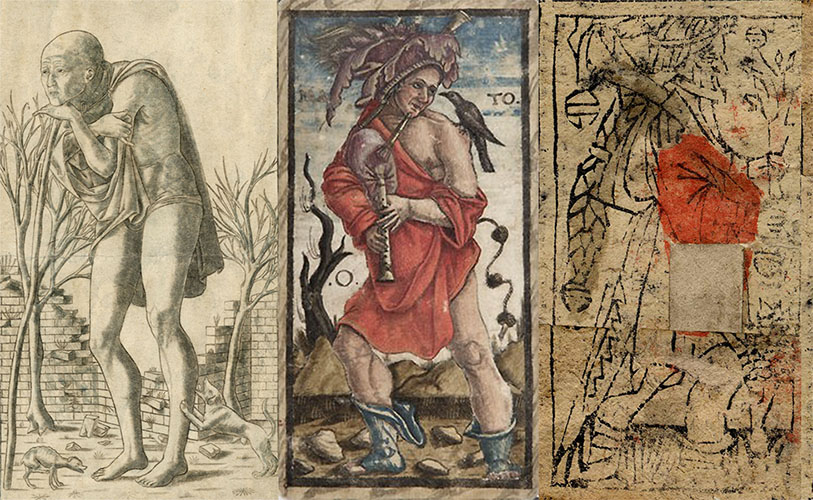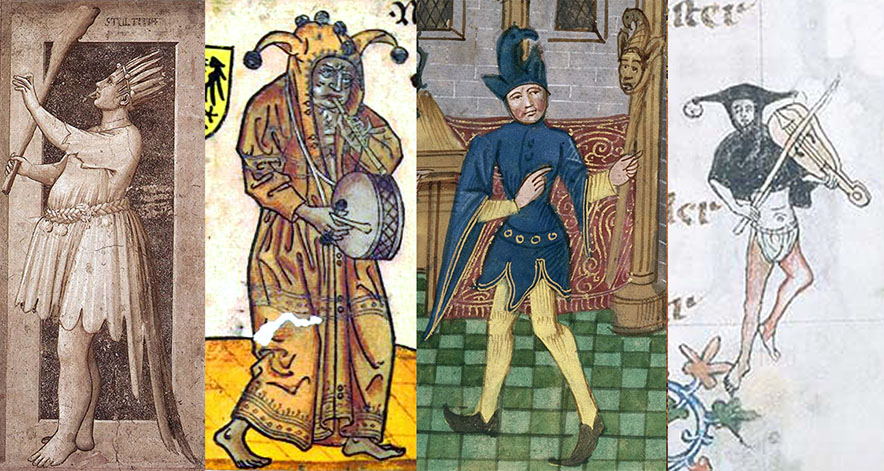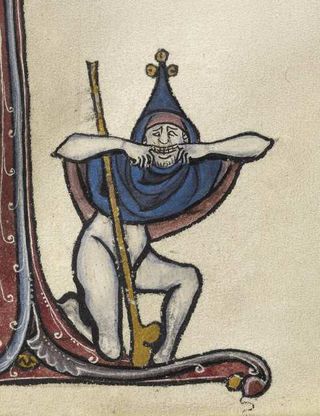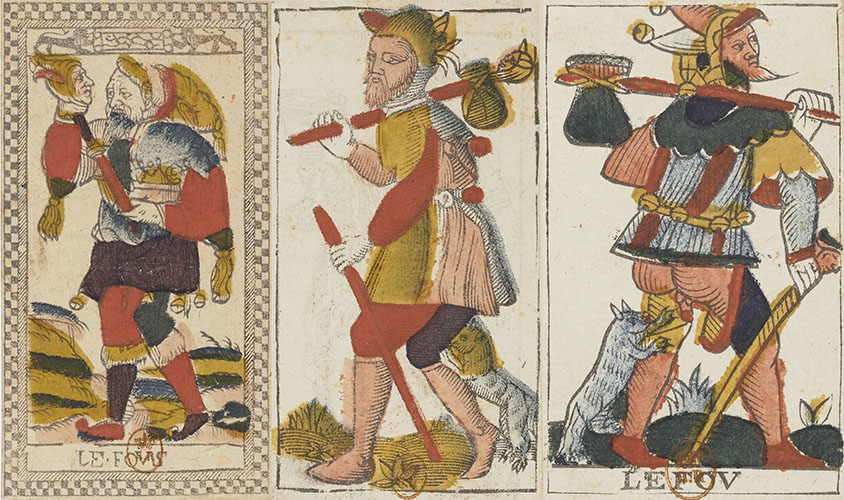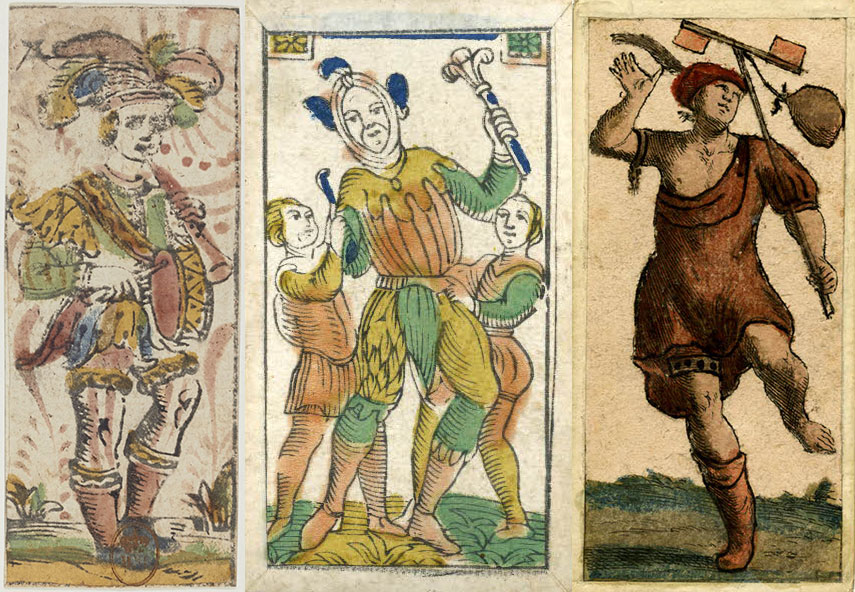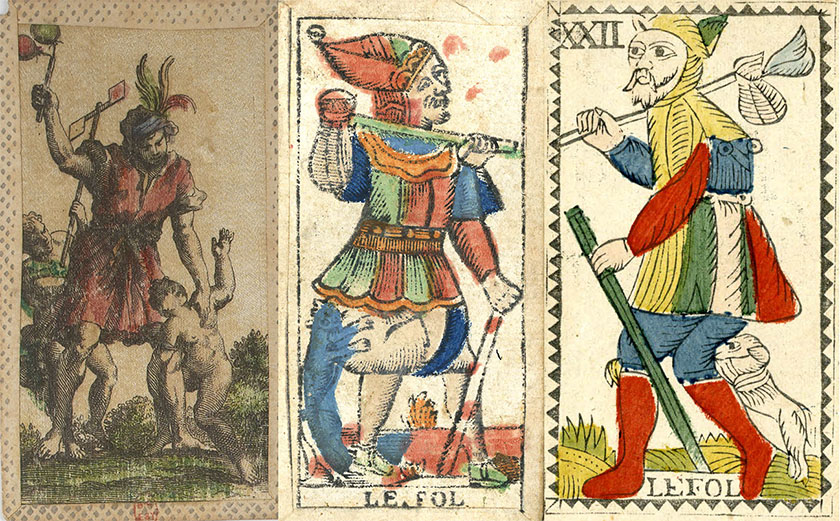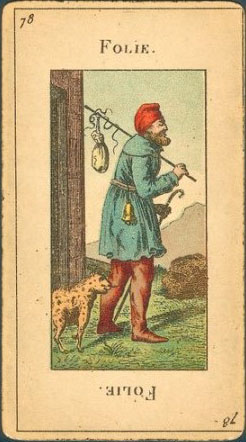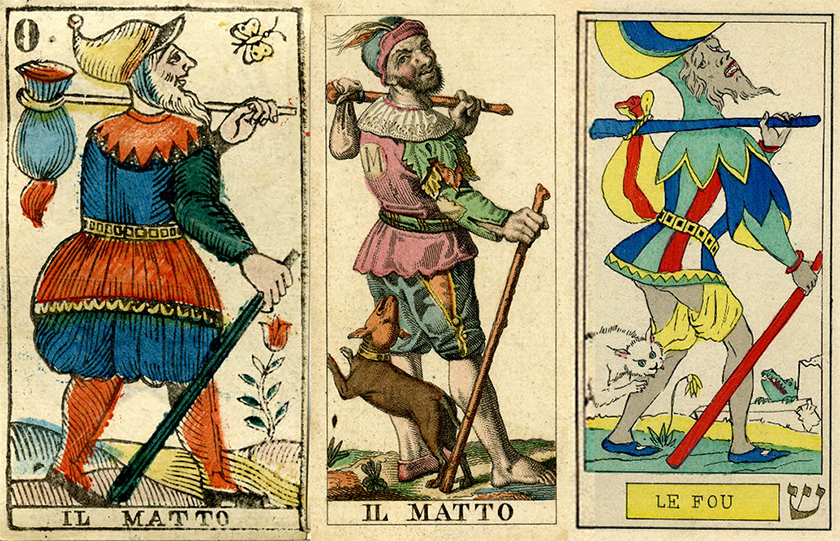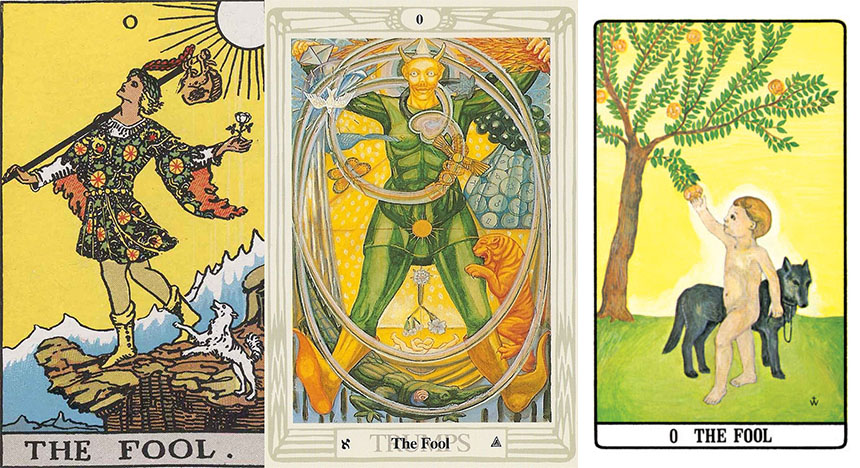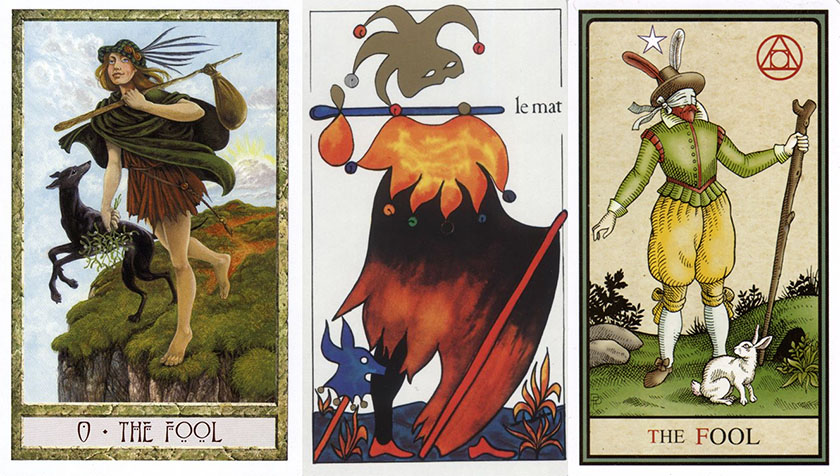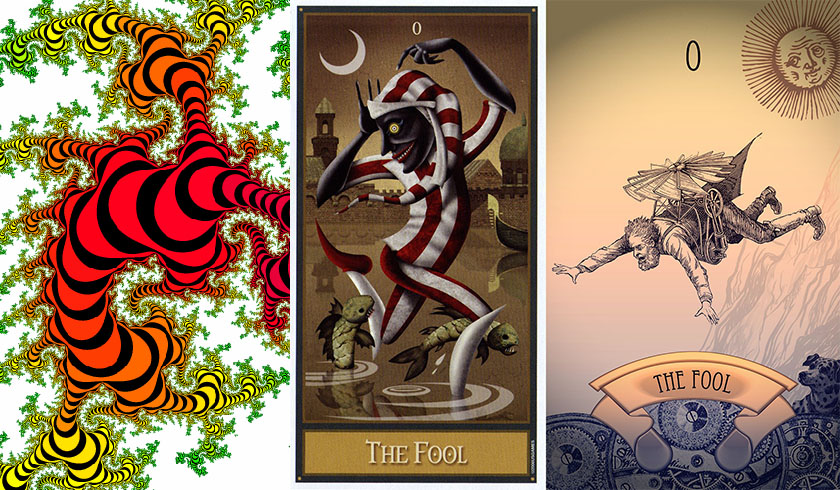THE TAROT WHEEL
IL MATTO - THE FOOL
The Fool made his first appearance in the 1454 Visconti Sforza deck with a 14 Trump structure. Here above we see his face. Apparently he is still a young man. He has blond curly hair and a small beard. But he does not care for his hair. In his hair, there are seven feathers, to express how light his mind is. He is looking at something, but he does not seem to understand. he looks amazed and amused at the same time.
In the Sermones de Ludo Cum Aliis, the sermon of an anonymous Franciscan of Dominican friar (see Tarotpedia), dated to the last quarter of the 15th Century, the card is called "El Matto", that translates to the Fool. Here we call him "Il Matto", his actual Italian name. In the Sermones the card is mentioned last, outside the Trump Structure. The sermon says that if you want to attribute this card a number, it should be zero or nothing. On the Marseille Tarot the card is called "Le Fou" (Jean Noblet), "Le Fol" (Type I TdM decks) or "Le Mat" (Type II TdM decks), all of them to be translated as "The Fool". Sometimes the card is also shown or referred to as "The Jester". Let us start with some images of the Fool from 15th Century Trionfi decks.
From left to right we have the Fool of the Visconti-Sforza deck (1452-1454), the Charles VI deck (>1460) and the Este deck (1473). The first of these three decks was commissioned by the Sforza court from Milan, the two others probably both by the Este court from Ferrara. On the Visconti-Sforza deck, he is barefoot and wears no trousers, only some kind of loincloth. He clearly is a poor man. His jacket is old and worn out. He has a big stick in his right hand, laying on his shoulder.
The Fool on the two Este cards is depicted as a buffoon. On both cards, he is also barefoot, has a tiny loincloth and wears the cap of a jester with two ass ears and a bell on top of the cap. Apparently, the Fool is situated on these two cards on a village fair, and so he represents a village Fool. On both cards, children are making the fool out of him, but this does not seem to bother them. On the rightmost Este card the children are tearing his loincloth down and on the other card they are throwing stones at him. Nothing can bother the Fool who is with his mind in another world. The two Fools are joyful, while ignoring their surroundings.
On all three cards, the Fool is a madman. He is going where he wants without following a specific direction. He's wandering from village to village, to find some foot, or he takes what nature is offering him. The Fool has no rules to obey, he does not even know this word.
From left to right we have here MISERO from the 1465 Mantegna prints, MATO from the 1493 Sola Busca deck and the Fool from the Budapest sheet, printed around 1500. MISERO represents extreme poverty. Note the little dog barking to chase him away, like we'll find on the Tarot of Marseille decks. MATO is a wandering musician playing a bagpipe. In that time in Art works, the Fool was often displayed with a music instrument. On the Budapest sheet, the Fool is shown as a wandering vagabond. He is holding a branch with leaves and has some bells attached to his clothes. In the years when the plague was devastating Europe, ill people had often bells attached to their clothes, to warn people to keep their children inside their house. Mentally ill people were having the same warning signs.
Foolishness is not a very popular subject. It was frequently associated with physical deformation, illnesses, nudity, poverty and music. The Fool itself as a subject, is regularly displayed as a court Jester, the opposite of stupidity. Some examples from Medieval Fools here below
All examples are from the 14th Century, except the second one that is from a 1455 German card game called the Ambras Hofamterspiel. This game has four suits, each suit representing a country (France, Germany, Bohemia and Hungary) and each suit is divided in 12 levels of society, from the Fool to the King. The first ten levels are numbered, the King and the Queen are unnumbered. The first picture is part of a fresco that Giotto di Bondone made in 1306 in the Scrovegni chapel that is situated in Padova, a town not far from Venice in Italy. In this fresco, foolishness is the vice opposite of the virtue of Prudence. The other two fools are dating from the mid 14th Century and are made in the Dutch-speaking Lowlands (the Netherlands or Belgium). The first one of these two is not really a fool, but a typical court Jester.
What are the features we can observe? The Fool of Giotto is very similar to the Visconti Sforza Fool, with feathers in his hair (also here seven feathers are visible), he is barefoot, has worn out clothing and a big stick in his right hand. The second and the fourth Fool are also barefoot, they wear a fool's cap with ass ears, bells attached to the ears, and they are playing music. The last Fool is as badly dressed as the Fools on the Este decks. On his lower body, he is wearing something that looks like a diaper. The court jester, on the other hand, has much more sophisticated clothing. On his feet elaborated shoes, on his body a very nice dress. His fool's cap shows the head of a bird, as does his stick. This kind of stick with the head of fool on top of it has become a typical attribute for court jesters.
These are just some random examples. Many others can be shown, most of them originating from medieval illuminated manuscripts. Some Fools are totally naked, wearing only a fool's cap, and often they have a stick. Here at right is such an example. The same variety of Fools can be encountered in later Tarot decks. In modern decks, the Fool can be anything, as long as he expresses a foolish behavior (or pure innocence). Let us continue with the Fool on Tarot cards from the 16th and 17th Century.
We have very few Tarot cards that date from the 16th Century, so there is no fool that can be shown. In the 17th Century, however, more decks were created and resisted through times, both in Italy and in France. Let us start with showing some 17th Century French Tarot cards. All three of them are printed in Paris and all are conserved there in the French National Library.
The three cards are very similar in paper and ink colors, it might very well that they have been printed on the same press. Even the pattern on the back of the cards is identical. From left to right we have the anonymous Tarot of Paris, created somewhere in the first half of the 17th Century, next the Fool of Jaques Vievil, printed around 1650 and finally the Tarot of Jean Noblet, the oldest known "Marseille" Tarot, created around 1659. The Fool of Jean Noblet is mirrored regarding the older two Tarot Fools, to emphasize that we are not looking at an image, but that the card is mirroring our Soul. For this reason, the Fool of Noblet is walking to the right and both others are walking to the left. The three Fools are very similar, they all have fool's caps, a fool's stick like the jesters have and bells attached to their clothing. All Fools are bearded. On the first and the third card appears the name of the card. The second and third cards have a lot in common. Like on the Mantegna card there is an animal jumping to the Fool, like it is chasing him, they have two sticks, and they have attached all their belongings on one of the sticks that they carry over their shoulder. Neither of the Fools is following a traced road.
The three French cards look very similar, with on each card a wandering Fool. There are differences in detail (look at the naked buttocks and genitals of the Noblet Fool), but these are just artistic variations on the same theme. In the same period in Italy there was much more variation in the Tarot decks, as you can see here below, The Fools look quite different. Again three examples printed in one single city, Bologna this time, where Tarot production was very active. We see here three typical examples from Fools made in the 17th Century in Bologna. The age of the cards is comparable with the previous three cards.
The leftmost card is an early 17th Century Tarocchino di Bologna, actually conserved in the French National Library. The two following cards are conserved in the British Museum. The second card is from a Minchiate deck produced in the 17th Century in Bologna and the last one is from a Tarocchino deck created between 1660 and 1665 by Giuseppe Mitelli, in order of the Bentivoglio, a wealthy Bolognese family.
The Tarocchino Fool is similar in conception to the Fool on the Ambras Hofamterspiel and the Minchiate Fool seams inspired by the Este cards. The Fool made by Giuseppe Mitelli is a original artistic production, not based on existing cards. We see a dancing Fool with one bare foot and one bare shoulder. In his hand, he holds a stick with on top a device that is turning with the wind.
The 18th Century is characterized by a stabilization in the different existing models. The Tarot is expanding all over Europe. Most decks are based on existing decks (especially the Tarot de Marseille) as we will see in the next examples of 18th Century Fools.
The first card is a Fool from a Minchiate deck produced in 1712 in Florence. The particularity of this deck is that the images are printed on silk. Remark the attribute that the boy behind the Fool is holding, that is identical to the one on the Mitelli Tarocchini decks. The deck is conserved in the French National Library. The second card is made by Francesco Berti in Bologna, at the end of the 17th Century. The deck is clearly inspired by the type I Marseille Tarot. Although produced in Italy, it conserves the French text. The same counts for cards produced in German-speaking regions, they also initially conserve the French text on the cards. The third card is the Fool from a deck produced somewhere in the eighteenth Century by Jean Gisaine in Brussels. It is typical for the Belgium Tarot style and inspired by the 16th Century deck from Jaques Vievil. The decks of Francesco Berti and Jean Gisaine are conserved in the British Museum.
In 1781 appears the 8th volume of "Le Monde Primitif", an encyclopedic work written by the French scientist Court de Gebelin. In this volume, he deals with Tarot cards, and identifies them as an old Egyptian Book. The Tarot and its supposed Egyptian origin would become very popular among French occultists, and especially by Jean-Baptiste Alliette. Two years later in 1783 he publishes under the pseudonym Etteilla a book called "Manière de se récréer avec le jeu de cartes nommées Tarots" (how to recreate yourself with the card game called Tarot) followed in 1793 by his version of the Tarot. Here at right a 19th Century faithful copy of the Fool of this deck, numbered 78.
The next three Fool cards are from the 19th Century. In this epoch, people lost interest for the Minchiate game. The Tarocchino deck continued to exist, but like modern cards it was double-headed. France had adapted its own suit symbols for the Tarot and replaced the traditional trump images with animals and later drawings of daily live. This type of Tarot is still very popular in France. The only traditional Tarot cards, that continued to be used, were the Tarot of Besançon and other derivates of the Tarot of Marseille. Here below three examples, all inspired by the Tarot of Marseille.
The cards are from left to right the Fool of the Vergnano Tarot, a deck in the Piemontese tradition, created around 1830 in Torino, the Soprafino Tarot created by Carlo della Rocco, published around 1835 by the German printer Gumppenberg in Milan and a Tarot published in 1889 by the Swiss occultist Oswald Wirth. This last deck was part of a long series of occult card decks. Vergnano created around the same time two different decks, one with French titles and the other with Italian titles. Gumppenberg, being one of Milan's major printing presses, publishes the Soprafino Tarot using the latest printing techniques. As a result, we have a very detailed image on the cards.
As we can see, although there are significant differences in the details, on all three cards basically this Fool is a typical Marseille Tarot Fool, a vagabond, wandering over the World, without destination and without plan. Domestic animals continue chasing him from our civilization, he is still not welcome among the other people. He is a Fool, an outsider, people are afraid of him. Remark that on the Vergnano Tarot, the animal has been replaced by a butterfly and a red flower. The butterfly is not chasing the Fool, in contrary, the Fool is following the butterfly on its seemingly random road from flower to flower.
With the French occultist movement, a big earthquake manages to shake the Tarot world. The Tarot would change profoundly, never to be the same again. The English occultist organization of the Golden Dawn embraced the Tarot and popularized it in the Anglo-Saxon world. One of the three founding members of the Golden Dawn, Samuel Liddell MacGregor Mathers, would have an enormous influence on the symbolism and the interpretation of the Tarot. He described the Fool as follows:
"A man with a fool's cap, dressed like a jester, with a stick and bundle over his shoulder. Before him is the butterfly of pleasure luring him on (while on some packs a tiger, in others a dog, attacks him from behind). It signifies Folly, Expiation."
Mathers would have a great influence on Arthur Edward Waite, better known as A.E. Waite. Waite entered the Golden Dawn order in 1896, seven years after its creation. Together with Pamela Colman Smith he created the Rider-Waite-Smith deck. And with the RWS deck, published in 1909, we enter in the 20th Century.
The first three 20th Century cards I show you are all related to the Golden Dawn. The first card is the Fool from the Rider-Waite-Smith deck. It is followed by the Fool from the Thoth Tarot, created between 1938 and 1943 by Lady Frieda Harris under guidance of Aleister Crowley, occultist and also member of the Golden Dawn. The deck was published for the first time in 1969, long after Crowley died. The third deck is the Golden Dawn Tarot, published in 1977 and created by Robert Wang under the guidance of Dr. Israel Regardie. The deck is based on a never published Tarot deck made by the Golden Dawn founding member S.L. MacGregor-Mathers. Isreal Regardie was an occultist and member of the Stella Matutina, a successor organization of the Hermetic Order of the Golden Dawn. Regardie had acquired the bulk of the Hermetic Order's documents. In his book "The Complete Golden Dawn System of Magic" Regardie has the following description of the Fool:
"This card as usually presented shows a man in motley striding along, heedless of the dog which tears his garments and threatens to attack him. In this is seen only the lower aspect of the card, giving no hint to the Divine Folly of which St. Paul speaks. But in the Order pack, an effort is made to reveal the more profound meaning. A naked child stands beneath a rose-tree bearing yellow roses - the golden Rose of Joy as well as the Rose of Silence. While reaching up to the Roses, he yet holds in leash a gray wolf, worldly wisdom held in check by perfect innocence. The colors are pale yellow, pale blue, greenish yellow - suggestive of the early dawn of a spring day."
Many modern Tarot decks are inspired by the RWS deck. As an example of these decks we show here the Druid Craft Tarot, created in 2004 by Will Worthington guided by Philip Carr-Gomm, Chief of the Order of Bards Ovates and Druids. Clones of the RWS deck are made on any theme you can imagine, here it is druidism. The second deck is the Fool of Le Tarot de la Rea, a modern interpretation of the Marseille Tarot, published in 1982 by Alain Bocher. The third example is the Fool of the Alchemical Tarot. This deck, created by Robert M Place, was first published in 1995. The card shown here is from the fourth edition of the deck, published 20 years later. This Tarot deck is not a clone of an existing deck, but an original creation based on alchemical tradition.
These three Tarot decks are still rather classic. As you can see in the following three examples, many modern decks are going further and further away from the traditional imagery.
The first card is the Fool from the Chaos Tarot, designed around 2001 by John Berger. With this deck, we are very far away from traditional imagery. With some wild imagination, we can imagine here a dancing Fool. The second deck is the Deviant Moon Tarot, which Patrick Valenza created when he was still a child. He published the deck in 2004. The images are loosely based on the RWS imagery, but with a very surrealistic moonlit atmosphere. The last card is the Fool from the unpublished Steampunk Tarot created by Rüdiger Seibert.
Although there are many differences in details, the Fool did not change a lot over the ages. He can be a vagabond, a dancing Fool, a musician, a lunatic, a beggar or all of them at the same time. Often he is wearing the clothes or the attributes of a Jester, but always he stays just a Fool. As such, he represents innocence, credulousness and gullibility in its purest form. On almost every card, he is portrayed as a person, wandering through an alien and hostile world. Sometimes he is alone, on other cards with kids or with an animal. He simply ignores them. The Fool does not recognize authority, and he doesn't have any plan. Frequently, he is ignoring or not even aware of his environment. He goes there, where life is taking him. And this is the power of the Fool, he accepts everything and is happy with the life he's living. Because he does what he wants, without thinking about his environment, the Fool has placed himself outside society. For this reason, the Fool has no number. Sometimes he is numbered 0, sometimes 22, sometimes 78, but in fact all this is not correct. The Fool has no fixed place and no number it should be.

